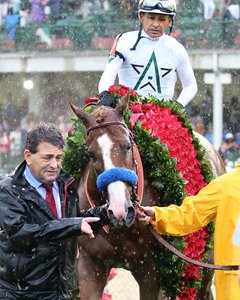Derby 144's Broken Jinxes and Superstitions


The story lines woven through this year's Run for the Roses included debate about the power of the Apollo Curse and later a reference to a superstition that green is bad luck in racing.
Both the "curse" and the malignant reputation of green were soundly thrashed when Justify romped to a 2 1/2-length win in the May 5 Kentucky Derby Presented by Woodford Reserve (G1).
Apollo—a gelded son of British sire Ashstead—had been, prior to this year, the last horse to win the Kentucky Derby without racing at 2. Because Apollo won the Derby 135 years ago, the Apollo Curse has been allowed to flourish.
The wearing of green and its influence in racing surfaced during the post-Derby press conference when trainer Bob Baffert made a reference to some hesitation he felt when his wife, Jill, appeared in a beautiful green dress.
"By the way, I didn't tell my wife ... that green is actually bad luck in horse racing. I didn't want to say anything," Baffert said.
"You told me I could wear it!" Jill protested during the press conference.
"A friend told me, 'Don't ever wear green, because it's bad luck.' She pulled it out, and I said, 'OK, Honey. We will see how good this horse is,'" Baffert said.
Later Baffert explained he has never actually believed the superstition regarding green, but was told about it a long time ago by a jockey agent he knew. And by the way, he added, Jill will not be wearing the same dress to the Preakness Stakes (G1) because they don't believe that it's suddenly become "lucky."
Green and its notorious influence on luck has a vague and ill-defined history, according to Phil Stevens Jr., a University at Buffalo associate professor of anthropology, who will soon be retiring after 49 years of teaching. He noted, however, that superstitions are typically born out of widely publicized, high-profile tragedies.
A possible contribution to the maligning of green goes back to England's Victorian era, when a bright pigment called "Scheele's Green" was popular among artists and home decorators, according to Smithsonian.com. Swedish chemist Carl Scheele created the pigment using copper arsenite. Toxic arsenic vapors and contact with Scheele green products were later blamed for thousands of deaths. At the same time, paint with a high lead content also existed and wreaked its own havoc, which further tarnished the popular color's reputation.
Auto racing gained its own superstition with green when in 1910 a wreck at the New York State Fair in Syracuse launched Lee Oldfield and his green car into the grandstands, where several spectators were killed, according to NASCAR.com. Then 10 years later, a two-car wreck at Beverly Hills Speedway involving a green car and driver Gaston Chevrolet, the younger brother of Chevrolet Motor Car Co. co-founder Louis Chevrolet, resulted in the deaths of three people, according to multiple sources.
As for green and its reputation in horse racing, the superstition is around but it lacks some standing because of contradictions. Animal Kingdom won the 2011 Kentucky Derby sporting Team Valor's red and green silks, California Chrome captured the Derby and Preakness Stakes (G1) with Victor Espinoza in purple and green, and WinStar Farm has now won two Kentucky Derbies with Super Saver in 2010 and now Justify both wearing its green and black logo on a white background.
Maybe the knock on green will start fading ... only to be replaced by something else.
"Horse racing is the classic gamble and probably the least well-predicted," Stevens said. "You have a beautifully trained horse and in a mile and a quarter anything can change the outcome. This is just ripe for superstitions."
Stevens noted that superstitions are most common among people in highly competitive situations that require split-second decisions. A study of baseball players done by George Gmelch, a cultural anthropologist professor at Union College, found far more superstitions among infielders than outfielders.
"In situations of split-second decisions and decisions that are really critical, you see more reliance on supernatural projections," Stevens said, referring to Gmelch's work. "Outfielders have more time to gauge the situation."
As for the Apollo Curse, well, it never really was a curse so much as the Apollo Jinx.
"There is a distinction between a curse and a jinx," Stevens said. "A curse involves spoken words with a negative outcome. The opposite of a blessing. But if things seem to go wrong because of some routine not followed or some expectation not met, that is a jinx. They are both legitimate concepts in the world of magical thinking."
Where curses and jinxes are similar is that beating them both require the same approach—positive thinking.
"If a person is convinced that things are going right, then they will have a positive attitude," Stevens said. "Negative thinking can also result in a negative outcome. Jinxes do have a psychological benefit to the believer as an explanation of failure. If you project outcomes onto some cosmic cause, then it relieves you of any blame. At the same time, if you can overcome or break the trend we're talking about, it can have a very positive psychological effect—Hurray! Look at what we did!"
Heading into Kentucky Derby 144, Baffert gave every indication that he believed Justify was ready to crush the jinx.
"The curse thing really didn't bother me. I was just worried about us, just make sure we did everything right," Baffert said. "We shipped right. Jimmy Barnes, all my team, the gallop boys. Everybody was in sync. Everybody stayed focused. We have been lucky enough to have these good horses."
